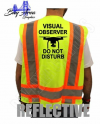- Joined
- Nov 12, 2019
- Messages
- 893
- Reactions
- 1,076
- Age
- 67
Exactly why I don't agree with law enforcement to enforce drone laws setup by the FAA. Anyone flying FPV can be cited because the regulations are easily misinterpreted. It doesn't matter what it really says or really means, all that matter is when it comes time to detain and cite you and then when it comes time to convict you. It's totally out of your hands when it comes to local law enforcement and you may stand a fighting chance if this is administrative action under FAA (federal) jurisdiction. Any officer for any reason can simply walk up to you, ask you to land your FPV and take off the goggles, then write you a citation for the dangerous operation of a UAV re: failure to maintain VLOS and walk away with your drone and there's nothing you can do about it [for now]....

I just might buy this for my visual observer so there will be no questions. Also a good idea to record the interaction.










